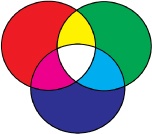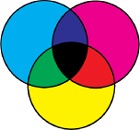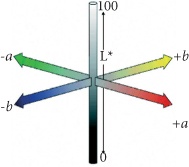Color models are used to describe and classify colors. Color models also describe the method of generating colors. This method defines the palette of colors as a combination of a few primary colors. The RGB color model, for instance, generates all possible colors as combinations of the primary colors red, green, and blue. When all three color components take on maximum value, the result is the color white. With color models, it is not necessary to have a separate ink for every printable color tone. Actually, it would be impossible to provide a separate ink for every conceivable color tone. Instead, the entire color spectrum is covered by mixing a few basic colors. In this way, in combination with the basic color of the medium, all colors can be generated. For a monitor, the basic color is black; for printing, it is the white paper.
In the RGB color model, all colors are created from different amounts of the primary colors red, green, and blue. This model is called an “additive” color system. When all three colors are at their maximum, they produce white. Black is created by setting all three color components to zero; it is the absence of any light. Monitors and film scanners work with the RGB color model. A monitor that is turned off is therefore always black. For printing image files, the RGB color model has to be converted to CYMK. For professional printing, this happens in prepress. For printing on your home computer, this is taken care of by the printer driver. That means manual conversion to CYMK can usually be omitted. In fact, manual conversion should be avoided, since image information is lost that can be important for further processing. You should not convert images from RGB to CMYK without a good reason to do so.
The CMY color model consists of the three primary colors cyan, magenta, and yellow. It is a “subtractive” color model. The sum of these three colors yields black. If all color values are zero, no ink will be printed and the result will be white – assuming the printing paper is white. The problem with the CMY color model is that a proper black can be obtained only from absolutely pure primary colors: cyan, magenta, and yellow. Even though three expensive layers of ink are put down, one usually gets only a dirty black-brown instead of pure black. It is considerably less expensive and better to add black as a spot color to the primary colors. This combination is called the CMYK color model (the “K” stands for “Key”). In this fashion, a single layer of ink can generate a deep black.
The Lab color space contains all colors that can be seen by the human eye. The three values L, a, and b define the color in a precise way. “L” stands for luminance, “a” stands for the red-green component, and “b” stands for the blue-yellow component – which is not very intuitive for most people. The color spectrum of the Lab model contains all colors of the RGB and the CMYK color spaces. Lab can therefore define colors precisely.
Unlike RGB and CMYK, the Lab color space is device-independent. However, it has to be converted first to either RGB or CMYK in order to be displayed or printed on any device. Without an output device such as a monitor or a printer, the user cannot do much with abstract color information. One practical use of the Lab color model is for describing color deviations precisely; for example, when calibrating devices. Also, the Lab color space is used as a transfer color space for converting images from one color space to the other. In that case, image files are first converted from the original color space to Lab, then from there to the target color space.




